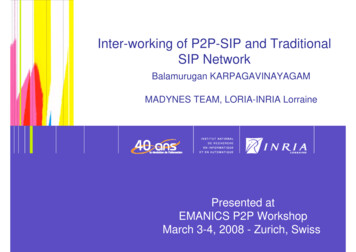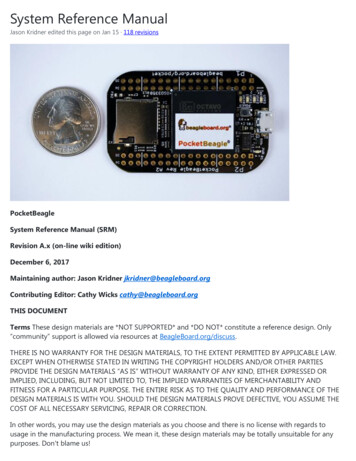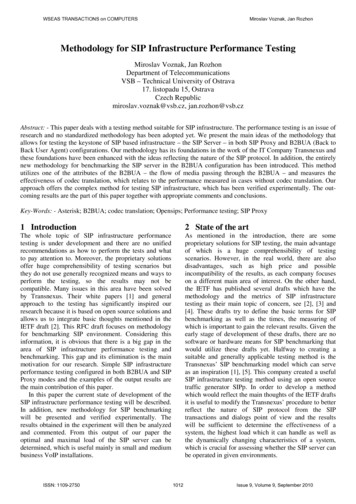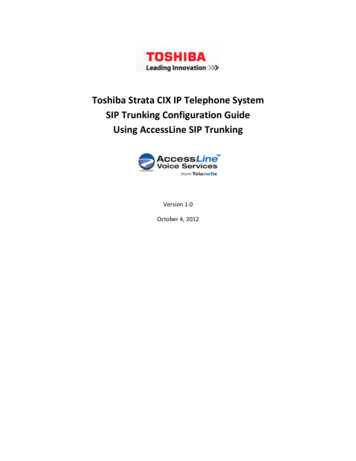
Transcription
1Inter-working of P2P-SIP and TraditionalSIP NetworkBalamurugan KARPAGAVINAYAGAMMADYNES TEAM, LORIA-INRIA LorrainePresented atEMANICS P2P WorkshopMarch 3-4, 2008 - Zurich, Swiss5 March 20081
Outline2 Introduction What is P2P-SIP?Why P2P-SIP?Different Approaches of P2P-SIP Inter-working of P2PSIP & Traditional SIP Integration in EMANICS VoIP testbed Conclusion5 March 20082
Introduction3 What is P2P-SIP ? Use the P2P techniques (like DHT) to resolve the SIP related functionsLeveraging the advantages of distributed network (P2P) for SIP network– Reliability, scalability etc., Why P2P-SIP ? NO centralized server– Lower Maintenance cost, configuration– Better reliability with higher Latency, scalability, robustness5 March 20083
Introduction (cont.)4Different Approaches of P2P-SIP SIP using P2P Replace the SIP location service with a P2P protocol P2P using SIP Implement P2P using SIP messaging i.e., Use SIP messages to transport P2P traffic5 March 20084
Introduction (cont.)5How is P2P-SIP works? Replace the SIP location service with a P2P protocolSIP URI are used for Hash key generation in DHT.– Eg.,Sip:bob@test.bamboo Hash(Key, identifier)Communication between the P2PSIP client and DHT uses P2P protocol5 March 20085
6Inter-working of P2PSIP and Traditional SIPnetworks Problems Finding the exact location of the clients (both P2P-SIPandconventional)– Because P2P-SIP domain uses overlay identifier rather than DNSentries.– Whereas conventional SIP uses DNS to locate domains Solution– Need a gateway (proxy) kind of approach Different Approaches P2P-SIP Peer can act as Standard SIP Proxy and Registrar for conventionalSIP UA– The peer can insert the UA in the distributed database– Can retrieve contact information from the distributed database whenproxying5 March 20086
7Inter-working of P2PSIP and Traditional SIPnetworks (cont.,) Different Approaches. Act as a SIP Proxy for the overlay– P2P-SIP peer has a fully qualified domain name (FQDN) that matchesthe overlay name . Use Hierarchical overlay architecture– Has two level of overlays (Higher and Lower)– Higher level overlay will serve as the gateway for the lower level– i.e., the higher level overlay will be connected to the internetand lower level is just a P2P-SIP overlay5 March 20087
P2P-SIP in EMANICS TestbedP2P-SIP Architecture8Components P2P nodes: deployed in EMANICSLAB A SIP Proxy Server: Serves as a Proxy forthe traditional SIP clients and also connectsto the P2P-SIP clients via an upper leveloverlay5 March 20088
P2P-SIP in EMANICS Testbed (cont.,)9 How is it deployed? We use an existing open source implementation called Olyo P2P-SIP basedVoIP system (http://code.google.com/p/olyo/)Uses Bamboo DHTA P2P-SIP adaptor (Modified PartySIP)– connects the SIP clients and P2P overlayInternal Structure of P2P-SIP user node5 March 2008Working of REGISTER and INVITE of two nodes inthe P2P-SIP overlay9
Conclusion10 About P2P-SIP P2P-SIP is still in the beginning stage of itsdevelopment and needs a standard architecturespecification for interworking with traditional SIPnetworks. Some open Issues (Research to be done) How do we connect many domains in the overlay?Should we register one domain in many overlays ?Define User management or buddy list?How are the authentication, authorization, accounting to be handled?Provide traditional services like Voicemail, conferencing, emergencyservices, etc.,P2P-SIP security (DoS attacks, etc.,)5 March 200810
11Thank youAny Questions?5 March 200811
1st EMANICS Peer-to-Peer Management WorkshopZurich, march 2008Peer-to-Peer SIPImplementation and monitoringUPI Research Team
Existing infrastructureVoIP testbed based on Asterisk servers servers are interconnected through IAX system is hierarchical and secured authentication is needed to join in latency is low, voicemail and conferencingare active; PSTN connectivity is enabled UPI EMANICS Research Center2
Map of the VoIP testbedUPI EMANICS Research Center3
Peer-to-peer architectures P2P is not new, file sharing services are using itfor quite some time with successevery user installs a copy of the network’s clientand it announces the others of it’s presence,location and shared content when connectingdata flows directly form one peer to anothersystem is reliable and scalable, without anyserver being a single point of failureUPI EMANICS Research Center4
Client/server vs P2PUPI EMANICS Research Center5
Commercial solution P2P Voice Skypefree for now, but closed source and proprietaryprotocols, highly encrypted; no compatibilityhybrid system, uses Global Index Server forauthentication, friends list and user lookupnodes with enough resources and bandwidthbecome super-nodes, routing traffic (act asproxy) for users behind NAT and firewallsUPI EMANICS Research Center6
P2P SIP architecture (1) SIP used as communication protocol between peers,and an existing P2P (preferably OSS) protocol for userregistration (REGISTER) and lookup;a ring-structured DHT like Chord or Bamboo reduceslatency to O(log(n)), because every peer keepsinformation about log(n) of its neighborsa SIP ID (sip:user@domain) is associated with a hashkey, based on the client’s IP addresssecurity may be an issue: privacy is not insured (calllogging), and DoS attacks are possiblesolution: a PKI combined with a web of trust gives resultsUPI EMANICS Research Center7
P2P SIP architecture (2) reliability: when a peer or a super-node shuts down, itsabsence is detected by the REFRESH messages thatremain unanswered and Chord structures of theneighbors are updated accordinglyvoicemail can be stored either at the sender, either on asuper-node and delivered later, when the client connectsa super-node can become a mixer for multi-partyconferencing between its clientsICE can be used for NAT traversal, as every peer hasintegrated STUN and TURN serverTested implementations: Olyo and P2P SIP MonitorUPI EMANICS Research Center8
Monitoring P2P SIP Nagios: widely used open-source monitoringplatform, running on Linux as a daemonopen, plug-in-based architecture, with a webbased GUI for graphs and reportsperiodically launches plug-ins against selectedhosts (defined IPs) to check service availabilityin case of failures, it can automatically alertadministrators by e-mail, Jabber or even SMShas the ability to automatically run errorcorrecting scripts without intervention, by SSHUPI EMANICS Research Center9
P2P monitoring diagramUPI EMANICS Research Center10
UPI EMANICS Research Center11
NSCA CommunicationUPI EMANICS Research Center12
check p2p plug-in for Nagios Perl script that sends an OPTIONS message to every P2P SIP client on thestandard port (5060), or a standard check http against 6301 port of thepartysip client (Olyo) client’s IP needed; solution: modify client to sendIP to a java server that updates hosts.cfganother option is that the client sends messages to the Nagios ServiceCheck Acceptor, calling send nsca from the client code: /usr/sbin/send nsca -H localhost -c /etc/send nsca.cfgUPI EMANICS Research Center13
1st EMANICS Peer-to-Peer Management WorkshopThank you for your attention!Questions & AnswersUPI Research Team
7 5 March 2008 7 Different Approaches. Act as a SIP Proxy for the overlay - P2P-SIP peer has a fully qualified domain name (FQDN) that matches the overlay name . Use Hierarchical overlay architecture - Has two level of overlays (Higher and Lower) - Higher level overlay will serve as the gateway for the lower level - i.e., the higher level overlay will be connected to the .










